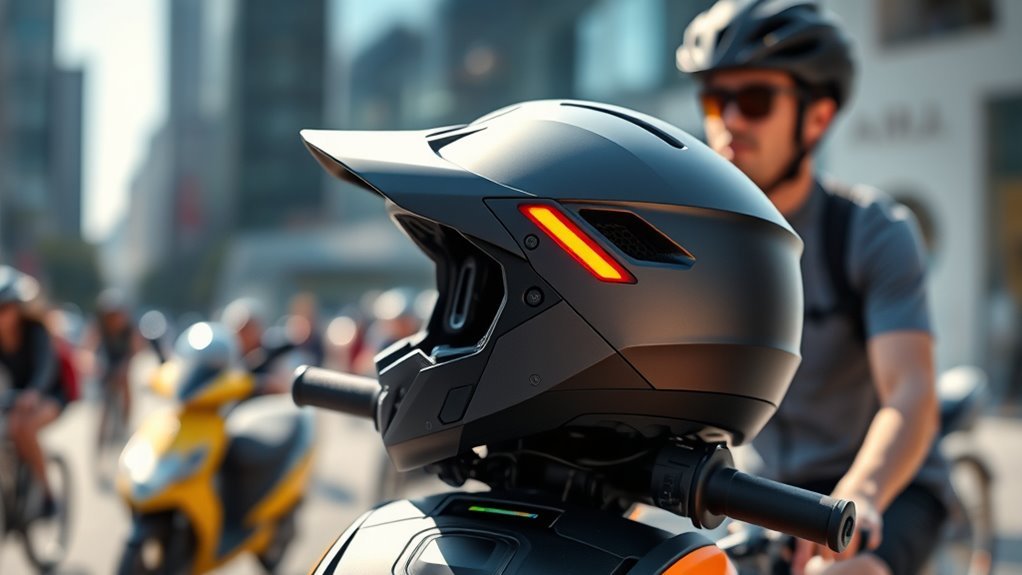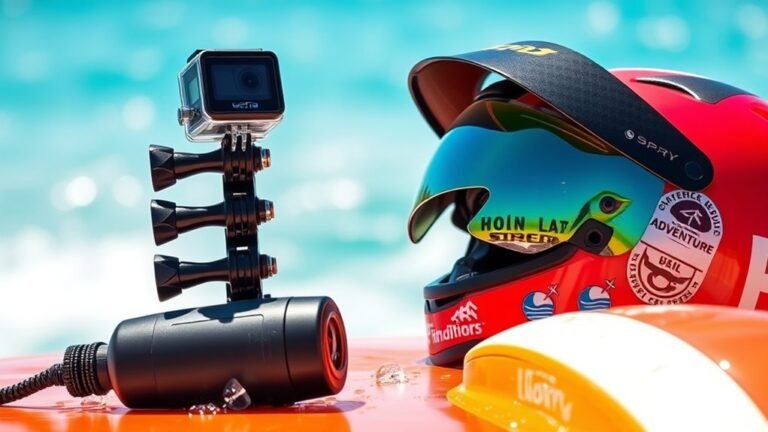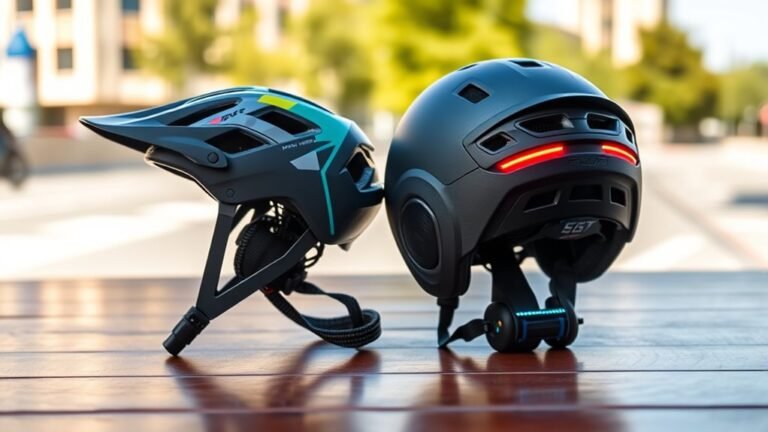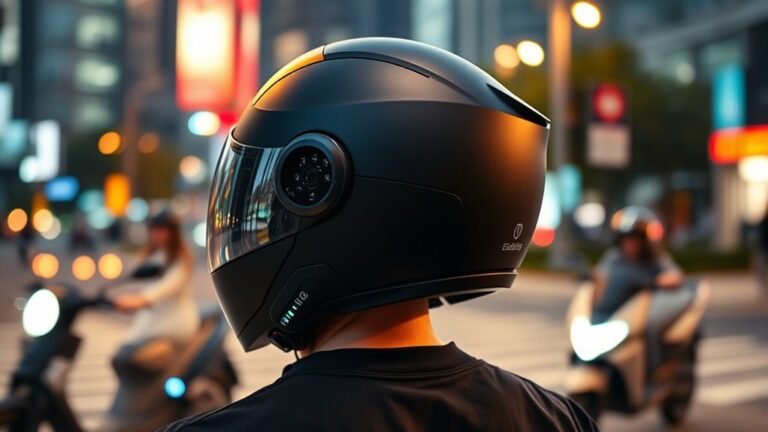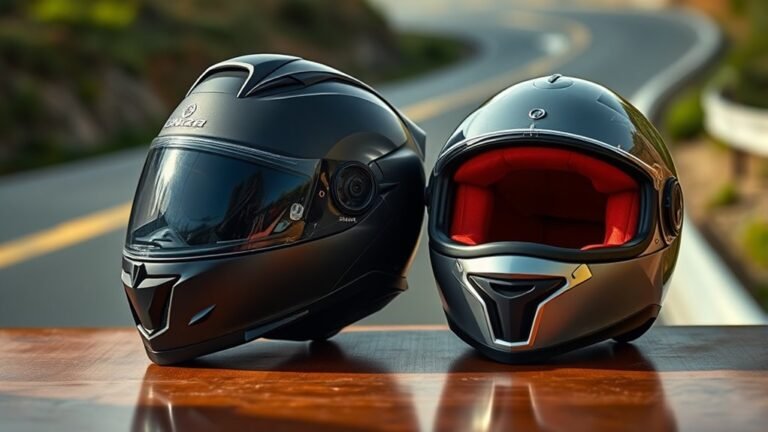Innovations in Helmet Safety for Micro-Mobility
Innovations in helmet safety for micro-mobility are enhancing rider protection considerably. Smart helmets now integrate Bluetooth connectivity, GPS navigation, and crash detection, improving real-time safety. Lightweight materials like carbon fiber and advanced protective foams offer better comfort and impact resistance. Visibility features, such as built-in LED lighting and reflective materials, are essential for night riding. Customization options cater to personal styles while adhering to safety standards. You’ll discover even more about how these advancements are shaping urban mobility.
The Rise of Smart Helmets
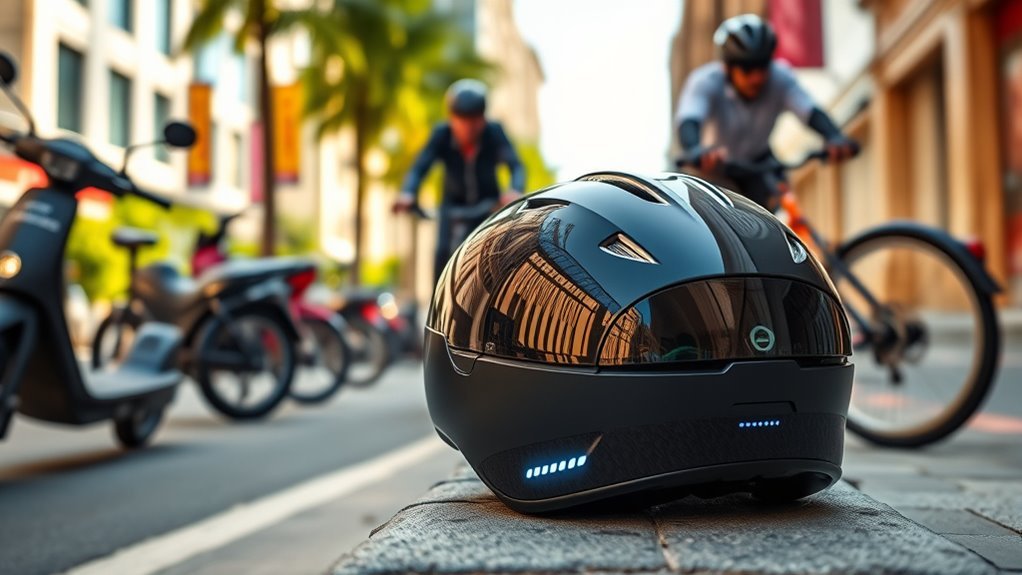
As the popularity of micro-mobility solutions like e-scooters and electric bikes increases, so does the need for enhanced safety measures, which is where smart helmets come into play. These helmets integrate smart features such as Bluetooth connectivity, GPS navigation, and crash detection, allowing you to stay connected while prioritizing safety. Innovations in helmet design focus on incorporating lightweight materials and aerodynamic shapes, ensuring comfort without compromising protection. The real-time data provided by these smart helmets can improve your riding experience, allowing you to make informed decisions on the road. By embracing this technology, you’re not just enhancing your safety; you’re also enjoying the freedom of exploration that micro-mobility offers, all while being more aware of your surroundings.
Lightweight Materials and Enhanced Protection
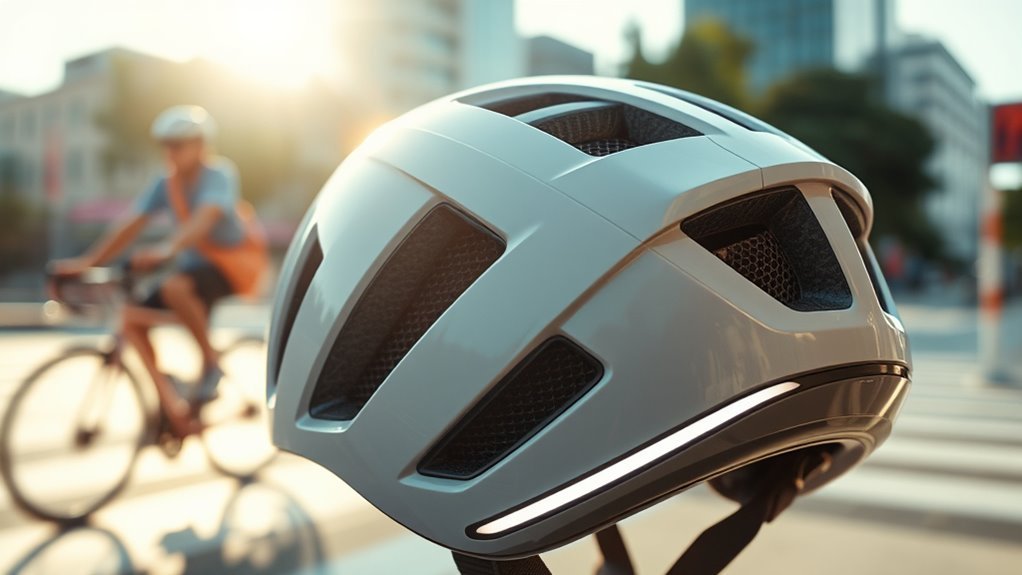
While safety remains paramount in micro-mobility, the advancement of lightweight materials in helmet design is transforming how we approach protection. Innovations such as lightweight composites and advanced protective foams are redefining helmet performance, making them not only safer but also more comfortable for users like you. These materials provide excellent energy absorption, reducing the impact force during accidents while minimizing weight. As you seek freedom in your rides, understanding these materials can enhance your safety experience.
| Material Type | Benefits | Examples |
|---|---|---|
| Lightweight Composites | High strength-to-weight ratio | Carbon fiber, Kevlar |
| Protective Foams | Energy absorption, comfort | EPS, EPP |
| Hybrid Materials | Combined benefits | Foam-fiber composites |
| Aerogel | Lightweight, insulating | Advanced aerogels |
| Expanded Polypropylene | Flexible, durable | Common helmet liner |
Integrated Communication Systems
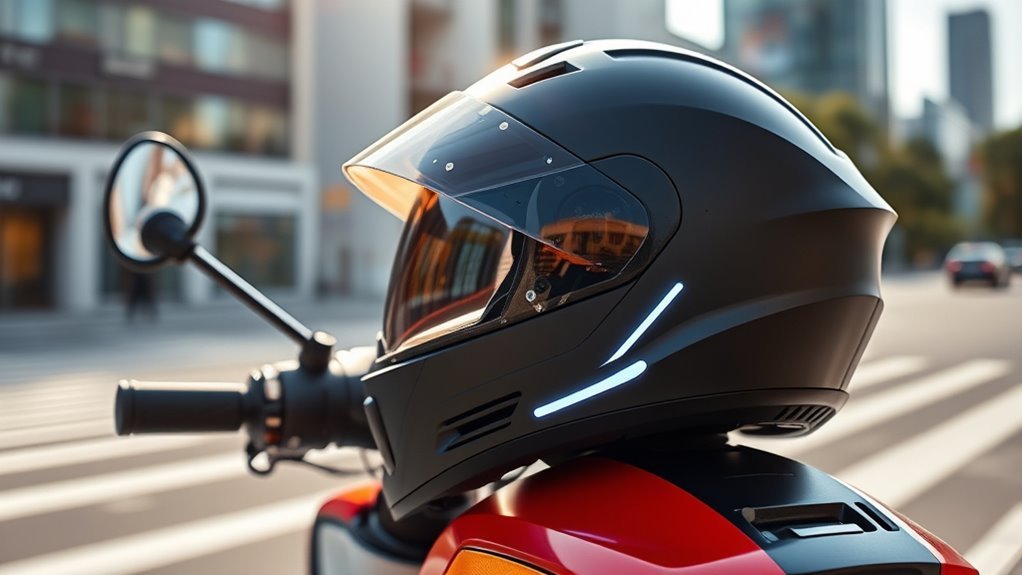
Integrated communication systems in helmets additionally enhance rider connectivity, allowing you to stay in touch without distractions. These systems can also incorporate safety alerts, providing real-time notifications about potential hazards. Furthermore, voice command features streamline operations, enabling hands-free control for improved focus on the road.
Enhanced Rider Connectivity
How can enhanced rider connectivity transform the micro-mobility experience? By integrating advanced communication systems into helmets, you can access a new level of interaction and safety. These connectivity features enable real-time rider feedback, allowing you to share performance data and receive insights about your ride. Imagine utilizing voice commands to navigate, access navigation prompts, or communicate seamlessly with fellow riders. Enhanced connectivity also means that you can easily connect to smart devices, ensuring you remain informed without compromising your freedom. With better integration of technology, your helmet becomes more than just protective gear; it evolves into an essential tool for enhancing the overall riding experience, fostering a sense of community and shared knowledge among micro-mobility enthusiasts.
Safety Alerts Integration
Enhanced rider connectivity lays the groundwork for integrating safety alerts within micro-mobility helmets. By incorporating advanced communication systems, these helmets can provide real-time safety notifications directly to you. Imagine receiving alerts about road hazards, vehicle proximity, or changes in weather conditions through integrated audio or visual systems. This technology allows you to remain aware of your surroundings without compromising your freedom of movement. Moreover, in the event of an accident, emergency alerts can be automatically dispatched to emergency services, ensuring swift assistance. The seamless integration of these features enhances not only your safety but also fosters a more informed riding experience. As micro-mobility continues to grow, the importance of these safety systems becomes increasingly crucial.
Voice Command Features
While maneuvering urban landscapes on micro-mobility devices, the ability to utilize voice command features in helmets can greatly streamline communication and enhance safety. With advanced voice recognition technology, you can enjoy hands-free operation, allowing you to focus on your ride. Here are some key benefits:
- Navigation Assistance: Get turn-by-turn directions without taking your eyes off the road.
- Emergency Alerts: Instantly contact emergency services with simple voice commands.
- Communication: Send and receive messages or calls without fumbling with your device.
- Music Control: Manage your playlist effortlessly, keeping your ride enjoyable and distraction-free.
These innovations not only improve convenience but also empower you to embrace your freedom while ensuring peak safety.
Built-in Lighting for Visibility
Built-in lighting in helmets greatly enhances your visibility during nighttime use, reducing the risk of accidents. Features like integrated turn signals provide clear communication to other road users, ensuring safer navigation. Additionally, rechargeable LED systems offer an eco-friendly solution while maintaining consistent performance.
Enhanced Nighttime Safety
As visibility decreases during nighttime rides, incorporating built-in lighting into helmets becomes essential for ensuring rider safety. Enhanced night vision is vital, and the integration of reflective materials alongside lighting can greatly improve your presence on the road. Consider these features:
- LED Lighting: Provides bright illumination, ensuring you’re seen by others.
- Reflective Strips: Enhance visibility from all angles, especially in low-light conditions.
- Adjustable Brightness: Tailor lighting intensity based on your environment, optimizing battery life and visibility.
- Automatic Activation: Sensors can trigger lights when it’s dark, so you never forget to turn them on.
These innovations not only promote safety but also empower you to ride freely, knowing you’re protected even in the dead of night.
Integrated Turn Signals
Incorporating integrated turn signals into helmets greatly enhances rider visibility and communication on the road. This turn signal innovation allows you to signal your intentions clearly, reducing the chance of accidents. By integrating lights directly into your helmet, you guarantee that every movement is visible, even in low-light conditions.
| Feature | Benefits | Impact on Safety |
|---|---|---|
| Integrated Signals | Clear communication | Reduces collision risks |
| Visibility Lights | Enhanced rider visibility | Improves awareness from others |
| User-Friendly Design | Easy activation | Encourages safe riding habits |
| Compact Integration | No bulky attachments | Maintains rider freedom |
These advancements not only elevate safety but also empower you to ride with confidence.
Rechargeable LED Features
While traditional lighting options can be cumbersome and require additional setup, rechargeable LED features in helmets offer a seamless solution for enhancing visibility. These built-in lights use rechargeable batteries, ensuring you’re always ready for your ride. Here’s how they improve safety:
- Increased Visibility: High LED brightness makes you stand out in low-light conditions.
- Convenience: No need for external lights; everything’s integrated.
- Sustainability: Rechargeable batteries reduce waste and provide a cost-effective solution.
- Customizable Settings: Many helmets allow you to adjust LED brightness or modes for different environments.
These features empower you to ride confidently, knowing you’re visible and safe, while maintaining the freedom that micro-mobility promises.
Customizable Design and Aesthetics
Customizable design and aesthetics play an important role in enhancing helmet appeal for micro-mobility users, particularly as individual preferences evolve. You’re likely seeking helmets that reflect your unique style and personality through personalized aesthetics. Customization options, such as interchangeable covers or adjustable colors, empower you to express yourself while maintaining safety. Trend-driven designs are also vital; they guarantee that your helmet not only meets safety standards but also aligns with current fashion. By prioritizing these customizable features, manufacturers cater to a diverse audience, allowing you to choose a helmet that feels less like a safety device and more like an extension of your individuality. Ultimately, this fusion of safety and self-expression can greatly enhance your riding experience.
Advanced Impact Testing Standards
As helmet designs evolve to reflect personal style, the significance of advanced impact testing standards becomes increasingly apparent. These standards guarantee that your helmet not only looks good but also offers maximum protection. Here’s what advanced impact testing involves:
- Multiple Impact Assessment: Evaluates performance under repeated impacts, mimicking real-world scenarios.
- Energy Absorption Tests: Measures how well the helmet dissipates energy during a collision.
- Penetration Resistance: Tests the helmet’s ability to withstand sharp objects, a critical factor in urban environments.
- Retention System Evaluation: Assesses the effectiveness of straps and buckles in keeping the helmet securely in place during an accident.
Adhering to these safety regulations is essential for guaranteeing you enjoy your freedom while riding with confidence.
The Future of Helmet Technology in Urban Mobility
With urban mobility expanding rapidly, the future of helmet technology is poised to incorporate innovative features that enhance both safety and user experience. Future designs will likely utilize advanced materials that are lighter yet stronger, improving comfort without sacrificing protection. Integration of smart technology, such as impact sensors and communication devices, could provide real-time data about urban regulations and potential hazards, allowing you to navigate more safely. In addition, modular designs may allow for customization based on varying urban environments, ensuring that helmets adapt to specific needs. As urban regulations evolve, helmets will need to comply with new standards, promoting a culture of safety while preserving the freedom you seek in urban mobility.
Frequently Asked Questions
How Do I Choose the Right Helmet for My Micro-Mobility Vehicle?
To choose the right helmet for your micro-mobility vehicle, start with proper helmet sizing; it should fit snugly without being uncomfortable. Measure your head circumference and compare it to the manufacturer’s size chart. Next, consider helmet features like impact resistance, ventilation, and weight; these enhance comfort and safety. Look for additional elements like reflective materials or integrated lights for visibility. With these factors, you’ll find a helmet that offers both freedom and protection.
Are Smart Helmets Compatible With All Types of Micro-Mobility Devices?
Smart helmets aren’t universally compatible with all micro-mobility devices. While many feature smart technology like Bluetooth connectivity and built-in lights, their functionality can depend on the specific device. Check the manufacturer’s specifications to verify compatibility with your scooter, bike, or e-scooter. By doing so, you’ll guarantee that you’re maximizing the smart features while enjoying the freedom of your ride, keeping safety and connectivity at the forefront of your experience.
What Is the Average Lifespan of a Safety Helmet?
The average lifespan of a safety helmet is typically around 3 to 5 years, depending on the helmet materials and usage. Exposure to UV light, sweat, and impact can degrade the structural integrity over time. It’s essential to adhere to safety standards, as these guarantee the helmet performs effectively during an impact. Regularly inspect your helmet for any signs of wear and replace it if you notice any damage or after a significant crash.
Can Helmet Technology Reduce the Likelihood of Accidents?
Yes, helmet technology can considerably reduce the likelihood of accidents. Through rigorous impact assessments, advanced materials and designs have been developed to absorb shock more effectively, enhancing accident prevention. While some may argue that helmets can create a false sense of security, evidence suggests that improved helmet technology contributes to overall safety. By understanding and embracing these innovations, you’re not just protecting yourself; you’re promoting a safer environment for all riders.
How Do I Properly Maintain My Helmet for Safety?
To properly maintain your helmet for safety, start with regular inspections. Check for cracks or dents in the shell and guarantee the straps are intact. For helmet cleaning, use mild soap and water, avoiding harsh chemicals that can degrade materials. Rinse thoroughly and let it air dry. It’s vital to replace your helmet every few years or after any significant impact to guarantee maximum protection. Prioritizing maintenance can enhance your riding experience and safety.
